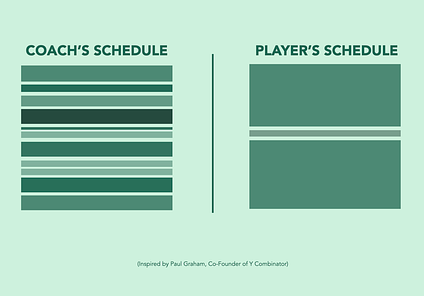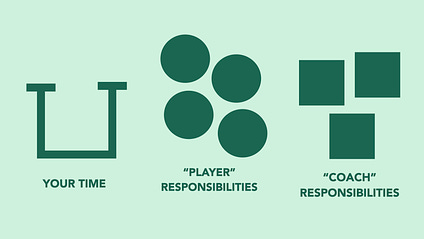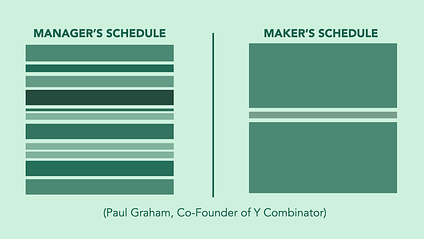The Impossible Role of a Player-Coach

Most leaders do not realize they’ve inadvertently signed up for two jobs – not one.
When you become a leader, yes, your new role now includes “management work.” Charting the overall vision, holding 1:1 meetings, helping set goals, keeping teams accountable, etc.
Yet you likely don’t ever fully relinquish the individual contributor (IC) work you previously owned.
This of of course depends on the size, stage, and organizational structure of your company…
But most of us leaders end up inhabiting a role known as a “player-coach.”
You’re responsible for your team’s outcomes AND your own IC outcomes.
You’re expected to fully guide and support your team, AND execute on specific deliverables to see a project through.
You’re doing two jobs, not just one.
To this day, I am a “player-coach” at my own company here at Canopy:
I own our marketing and content, writing every newsletter post (including this one!), running our events, creating leadership content — but also lead our overall team vision, strategy, and more, as CEO.
Leaders at much bigger, more prominent companies have occupied this role as well…
Tobi Lütke, CEO and co-founder of Shopify, an organization with more than 8,000 people, still codes.
Steve Jobs, founder and former CEO of Apple, famously would participate in the details of product development and UI product reviews.
Yet it’s a real struggle to do well.
Especially if it’s not of your own volition: Few things are more taxing than being a front-line manager asked by your senior leadership team to be a “player-coach,” They often don’t understand the implications of doing two jobs at once…
Double the number of priorities. Splitting time that you don’t have. Constantly context-switching.
The workload, so overwhelming, so daunting, some days you feel you’re failing at all things…
How do you it? Can you survive – dare I even say thrive – when you do two jobs at once?
Or are you resigned to feeling perpetually “behind” and depleted so greatly that no amount of vacation days could resuscitate you?
I’ve personally struggled to find some modicum of “balance” over my past 10 years as a “player-CEO.” After many personal foibles, and our work at Canopy, with 30,000+ leaders, I have an answer for you:
There is a path forward.
It is possible to be an effective player-coach without completely exhausting yourself.
But it requires some fundamental shifts in your own mindset– and your senior leadership team’s.
From our research at Canopy, working with tens of thousands of leaders over the past decade, here’s what I’ve learned to be an effective player coach in a sustainable way:
Destroy the myth of balance.
Balance is often an unhelpful framework for leaders. Balance implies some elegant, perfect alignment of time and priorities that somehow always equals a whole. Balance implies that “it can all fit” if you simply rearrange appropriately.
This couldn’t be further from reality. When you have two jobs and not one – player AND coach – you have more things to do than available time given. It can’t all fit.
More importantly: We shouldn’t try to make it all fit.
Paul Graham, co-founder of Y Combinator, once wrote about the difference between a “Maker’s Schedule” and a “Manager’s Schedule.”
A Manager’s Schedule is full of meetings: Team meetings, 1:1s with team members, strategy meetings.
A Maker’s Schedule has no meetings: Just big blocks of time for deep work to get IC work done.
So if you are both a player AND a coach, you cannot simultaneously have both schedules at the exact same time. It’s impossible.
Being an effective player-coach requires accepting this reality, and seeking a different framework for how we operate….
Introducing: “Fluid Focus”
Instead of seeking “balance” – a false narrative that “you can fit it all in” if you just prioritize correctly – shift to what I call “fluid focus.”
Fluid focus means choosing one role at a time – either the player OR the coach — and then changing that focus, as context as requires.
Fluid focus rejects the idea that “it can all fit”, and replaces it with the practical understanding of doing just one job, at one time. And then changing that job, when needed.
You’re never trying to have the Manager and the Maker’s Schedule at the same time.
Tactically, here’s what I suggest based on working with 30,000+ managers, how to best do this, and how to make this impossible role feel more possible…
(1) Decide which role takes precedence, at this moment.
Renounce any ideal “well-roundedness” for allocating your time. Accept that a trade must be made.
Choose 1 role to focus on – player OR coach – for a specific time period. This month, this week, this afternoon, this hour….
Commit fully to the trade. “Today, I am a player or a coach – but not both.”
Oftentimes, these trades are excruciating to make (or else we would make them more often). To help guide which role takes precedence in a certain time period, ask yourself:
-
What is the most meaningful goal + focus my organization has right now, and how can I best contribute toward that?
-
What is “success” for our team, and what can I do to put my team in the best position to succeed?
-
Where can I uniquely contribute to my team that would be high leverage?
-
What’s my highest use at this moment?
(2) Make this role, at this moment, clear to your team.
It might be obvious to you why you’re making a trade – but it’s not obvious always to our team.
Be sure to clearly communicate to your team:
-
Why you’re making the change in focus.
-
How expectations + interactions will change.
-
Timeframe for this change in focus.
Here’s an example for what that might look like:
“Because of our new company goals, I’m needing to change my focus to be more project-oriented for the next few weeks. As a result, I will need to scale back my participation in some team meetings. This is temporary, and just until we get this specific project out the door in X weeks…”
(3) Make this role, at this moment, clear to your supervisor.
Your supervisor may not have the full picture. They may not even be aware that they’re asking you to do two jobs instead of one.
You can help shine a light on this, and make sure you both have the same expectations for what “success” is in your role that is helpful, and non-resentful.
Phrases you can use to do this include saying:
-
“I’m noticing that my focus in more of a ‘coach’ role would best benefit the team…”
-
“I think this would have the greatest impact on the goals we’re trying to achieve…”
-
“Here’s an example of how this might feel / how things would be different…”
-
“This shift to ‘coach’ would be temporary. I’m envisioning this timeframe…”
-
“What do you think?”
You’re sharing a unique, on-the-ground insight how to best help the team. And you’re sharing this out of a desire to be helpful to your supervisor.
Make this intention clear in your communications. Your supervisor will receive it as such, when you do.
(4) Regularly reassess, readjust, as needed.
“Fluid focus” means this focus can change over time. You’ll want to regularly relook at whether or not the role you chose to focus on is in fact the right one for this moment in time.
Some questions to ask yourself to help determine this include:
-
Have our organization’s goals changed?
-
Has our definition of “success” changed?
-
Have my team’s needs changed?
-
Are there any opportunities where I can uniquely contribute to my team that would be high leverage?
You can always change your mind. If something comes up that makes you realize you need to shift focus, fully do so.
Caveats to note when implementing “fluid focus”…
Context-switching is exhausting. “Fluid focus” entails intense context-switching… And that comes at a cost. Research has shown that productivity can be reduced by 40% when context-switching. Note the labor of this, and plan for this. This may mean fewer priorities that you tackle in each role. Or creating a buffer or transition period when you are switching between roles.
Embrace a monthly cadence of recalibration. Look to re-evaluate your trades between “player” and “coach” roles once a month. Once a month is a suitable cadence because it allows you time to make changes in your focus, without disrupting the flow too much of what you’re already focused on.
Personal bias can be a trapdoor. Be wary of which role you personally enjoy more: Player or coach. It can be easy to listen to our own preferences instead of what the organization in fact needs from us. This isn’t inherently bad – just something to be mindful of. If we over-index on our personal preferences for the type of work we like the most, we may miss an opportunity to support our team in the way that’s most helpful.
Fluidly forward
This is not an exhaustive framework — merely a starting place for trying to reconcile current near-possible reality. What to do with all your overflowing to-dos for your IC work and back-to-back meetings for your leadership work.
Remind yourself: You can’t – and shouldn’t try – to fit it all in. Don’t judge yourself for previously trying.
Instead, get real about what matters most for your organization. Accept the trade you are making.
Remember there is no such things as two No. 1 priorities.
To do two jobs well, you have to do them one at a time.
Wishing you my very best as you look to move forward more fluidly.
I’ll be right there alongside you, trying to put “fluid focus” more into practice, myself.
-Claire
Thanks for reading Canopy Newsletter! Subscribe for free to receive new posts and support my work.


